
Philippine Defense Today (Adroth.ph)
In Defense of the Republic of the PhilippinesBarring any significant reversals (which still remain possible as of writing), the South Korean KAI Golden Eagle appears poised to become the most sophisticated combat aircraft ever to enter service with the Philippine Air Force. It is a 21st century aircraft that will mark the start of the age of Fly-By-Wire for the PAF. The Aermacchi AS-211, the long serving but ill-suited, basic-jet-trainer-turned-makeshift-multirole-fighter will no longer be the PAF’s solitary connection to the combat-jet age.
But aside from the technological advancements that will prepare the PAF for true Multi-Role Fighters (MRF) capability, what does the Geagle really bring to the table? Where does it put us in terms of capability? The answers require data that are not readily available in the public space. However we can glean some insight by comparing this aircraft with what previously was the most advanced fighter in PAF service: the Vought F-8 Crusader. This Vietnam War veteran gave the PAF true all-weather interception capability and featured the most capable avionics suite in a PAF fighter up to that point. It is therefore a fitting yardstick for capability enhancement.
The following table puts together a simplistic comparison of both aircraft. More data will be added to this table over time. There are many other factors that affect aircraft performance beyond what is apparent in the specifications listed here. However, the Geagle’s limited range and a prevailing lack of Beyond Visual Range (BVR) engagement capability are both readily apparent.
While the Geagle is heads and shoulders above the S211 in a combat role . . . a need for a more capable aircraft in the near future remains necessary to meet the threats of today. To quote a Timawan in the AFP: “We are doomed if accept a Lead-In Fighter Trainer as our frontliner”.
| Specification | F-8H Crusader | FA-50 Golden Eagle | ||
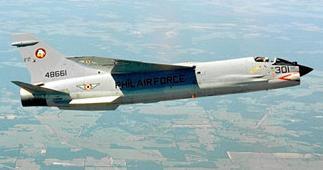
Photo c/o Vought |

Photo c/o Korean Aerospace |
|||
| Crew | One | Two | ||
| Length | 54′ 3″ | 42′ 7″ | ||
| Height | 15′ 9″ | 15′ 8″ | ||
| Wing area | 375 sq. ft. | 255 sq. ft. | Wingspan | 35′ 8″ | 29′ 11″ |
| Empty weight | 16,483 lbs | 14,285 lbs | ||
| Max take off weight | 27,938 lbs | 27,300 lbs | ||
| Powerplant | Pratt & Whitney J-57-P-4A | General Electric F404-102 | ||
| Range | 1,295 miles | 999.46 miles | ||
| Speed | Mach 1.5+ | Mach 1.5 | ||
| Avionics | Magnavox AN/APQ-83 fire control radar | For the FA version. Actual specs for PAF may vary:IAI EL/M-2032 Fire Control Radar Tactical Data-Link System Fly-by-wire digital flight controls Night Vision Imaging System (NVIS) Hands-On Throttle and Stick (HOTAS) Multifunction Displays (MFD) |
||
| Armament | Four Colt Mk.12 20mm guns AIM-9 AGM-12 Bullpup |
One 20mm M61 3-barrel cannon AIM-9 AGM-65 Maverick JDAM |
||
| Beyond Visual Range(BVR) capability | None | Uncertain | ||
| In-flight refuelling | Yes | None (proposed) |
References
- Jane’s All the World’s Aircraft (Updated October 2012)
- http://www.globalsecurity.org/military/systems/aircraft/f-8-specs.htm
- http://wiki.scramble.nl/index.php/Chance_Vought_F-8_Crusader
- http://www.airforce-technology.com/projects/t-50/
- http://www.koreaaero.com/english/product/fixedwing_t-50.asp
- http://www.deagel.com/news/Republic-of-Korea-Air-Force-Selects-ELM-2032-Fire-Control-Radar-for-its-T-50-Training-Jet_n000006581.aspx
Responding to continued Chinese refusal to end their occupation of Bajo de Masinloc / Panatag Shoal, the Philippine Department of Foreign Affairs has announced that it would bring China before an Arbitration Tribunal in accordance with the United Nations Convention on the Law of the Sea. The following is an excerpt of the DFA press release:
The Philippines has exhausted almost all political and diplomatic avenues for a peaceful negotiated settlement of its maritime dispute with China. On numerous occasions, dating back to 1995, the Philippines has been exchanging views with China to peacefully settle these disputes. To this day, a solution is still elusive. We hope that the Arbitral Proceedings shall bring this dispute to a durable solution.
< Edited >
Allow me, however, to highlight some salient points in the Notification and Statement of Claim:
The Philippines asserts that China’s so-called nine-dash line claim that encompasses virtually the entire South China Sea/West Philippine Sea is contrary to UNCLOS and thus unlawful.
Within the maritime area encompassed by the 9-dash line, China has also laid claim to, occupied and built structures on certain submerged banks, reefs and low tide elevations that do not qualify as islands under UNCLOS, but are parts of the Philippine continental shelf, or the international seabed. In addition, China has occupied certain small, uninhabitable coral projections that are barely above water at high tide, and which are “rocks” under Article 121 (3) of UNCLOS.
China has interfered with the lawful exercise by the Philippines of its rights within its legitimate maritime zones, as well as to the aforementioned features and their surrounding waters.
The Philippines is conscious of China’s Declaration of August 25, 2006 under Article 298 of UNCLOS (regarding optional exceptions to the compulsory proceedings), and has avoided raising subjects or making claims that China has, by virtue of that Declaration, excluded from arbitral jurisdiction.
In this context, the Philippines is requesting the Arbitral Tribunal to issue an Award that, among others:
– Declares that China’s rights in regard to maritime areas in the South China Sea, like the rights of the Philippines, are those that are established by UNCLOS, and consist of its rights to a Territorial Sea and Contiguous Zone under Part II of UNCLOS, to an EEZ under Part V, and to a Continental Shelf under Part VI;
– Declares that China’s maritime claims in the SCS based on its so-called nine-dash line are contrary to UNCLOS and invalid;
– Requires China to bring its domestic legislation into conformity with its obligations under UNCLOS; and
– Requires that China desist from activities that violate the rights of the Philippines in its maritime domain in the West Philippine Sea.
The Philippines asserts that the Arbitral Tribunal has jurisdiction to hear and make an award based on its Notification and Statement of Claim because the dispute is about the interpretation and application by States Parties of their obligations under the UNCLOS. Article 287 (1) of UNCLOS provides that “settlement of disputes concerning the interpretation and application of this Convention” may be referred by the Parties for resolution under Part XV of UNCLOS.
Article 287 of UNCLOS: Choice of procedure appears below.
1. When signing, ratifying or acceding to this Convention or at any time thereafter, a State shall be free to choose, by means of a written declaration, one or more of the following means for the settlement of disputes concerning the interpretation or application of this Convention:
(a) the International Tribunal for the Law of the Sea established in accordance with Annex VI;
(b) the International Court of Justice;
(c) an arbitral tribunal constituted in accordance with Annex VII;
(d) a special arbitral tribunal constituted in accordance with Annex VIII for one or more of the categories of disputes specified therein.
2. A declaration made under paragraph 1 shall not affect or be affected by the obligation of a State Party to accept the jurisdiction of the Seabed Disputes Chamber of the International Tribunal for the Law of the Sea to the extent and in the manner provided for in Part XI, section 5.
3. A State Party, which is a party to a dispute not covered by a declaration in force, shall be deemed to have accepted arbitration in accordance with Annex VII.
4. If the parties to a dispute have accepted the same procedure for the settlement of the dispute, it may be submitted only to that procedure, unless the parties otherwise agree.
5. If the parties to a dispute have not accepted the same procedure for the settlement of the dispute, it may be submitted only to arbitration in accordance with Annex VII, unless the parties otherwise agree.
6. A declaration made under paragraph 1 shall remain in force until three months after notice of revocation has been deposited with the Secretary-General of the United Nations.
7. A new declaration, a notice of revocation or the expiry of a declaration does not in any way affect proceedings pending before a court or tribunal having jurisdiction under this article, unless the parties otherwise agree.
8. Declarations and notices referred to in this article shall be deposited with the Secretary-General of the United Nations, who shall transmit copies thereof to the States Parties.
2012: What’s happening in the AFP capability upgrade program?
Tuesday , 1, January 2013 AFP modernization 1 CommentIf 2011 was the modernization year of the Philippine Navy, the year 2012 was a more balanced period with significant acquisitions for all services. The following table shows some of the projects completed for each service. Note that this is not an exhaustive list of all acquisitions that occurred in the past year, and omits projects for which details are still missing as of writing. It also does not include the significant number of modernization projects that are still in various stages of completion.
 |
Combat Utility Helicopter Project |  |
The first batch of three W-3 Sokol helicopters, out of a total of 8 aircraft, were delivered on March 9, 2012.Timawa discussion here |
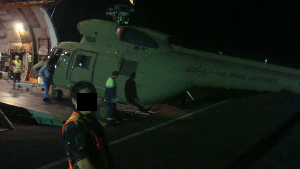 |
The second batch of W-3 Sokols were delivered on November 28, 2012.Timawa.net discussion here | ||
| C-130 refurbishment program | 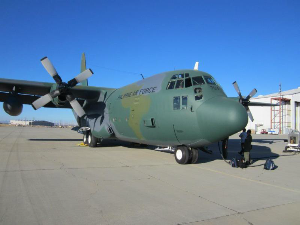 |
C-130H #4704 returned from a Programmed Depot Maintenance cycle in the United States on October 2012Timawa.net discussion here | |
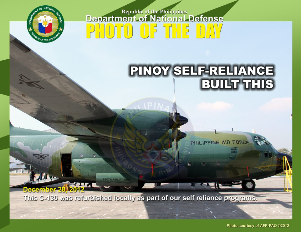 |
C-130B #3633 underwent its Programmed Depot Maintenance at the 410th Maintenance Wing in Clark AFB. It re-entered service on December 28, 2012.Timawa.net discussion here | ||
 |
BRP Ramon A Alcaraz (PF-16) |  |
The former WHEC-716, USCGC Dallas, was turned over to the Philippine Navy on May 22, 2012 and re-christened the BRP Ramon A Alcaraz (PF-16)Timawa.net discussion here |
| Multi-Purpose Assault Craft Mk.2 | 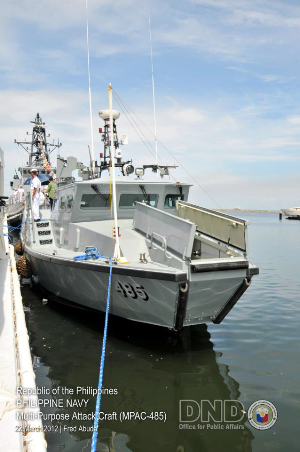 |
The Multi-Purpose Assault Craft (MPAC) Mk.2, which were entirely manufactured in the Philippines, were commissioned in August 2012. Three units were accepted.Timawa.net discussion here | |
 |
KM-451 ambulances |  |
The latest variant of the Kia KM45x series of trucks were revealed to the public on AFP Day 2012. 60 units were acquired.Timawa.net discussion here |
| M-16A1 rehabilitation program |  |
The Government Arsenal’s newly formed Small Arms Repair and Upgrade Division turned over the first 200 refurbished rifles to the AFP. Eventually 8,000 rifles will be repaired.Timawa.net discussion here |
Three operational C-130s at last
Monday , 31, December 2012 C-130, Philippine Air Force Leave a commentThe following DND photograph captures a significant milestone in recent PAF history: the return of the rule-of-three to its airlift operations. Aircraft #4704, which recently arrived from a PDM cycle in the United States, and #4726, the PAF workhorse in recent years.
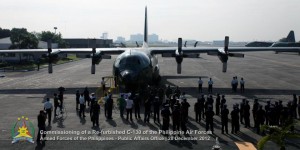 |
Touted as a milestone in self-reliance, the Philippine Air Force completed Programmed Depot Maintenance (PDM) for C-130B #3633 through the efforts of its own personnel at the 410th Maintenance Wing. Lockheed-Martin endorsed consultants were reportedly on hand to ensure compliance with industry standards.It was the first time the PAF had ever undertaken a project of this magnitude. Previous PDM efforts had either been done in Malaysia, or in-country through Asian Aerospace — a Lockheed-Martin approved contractor. As of writing, it is unclear if Asian Aerospace provided assistance for the project.
At the turnover ceremony for the refurbished Hercules, PAF Vice Commander MGEN Raul Dimatactac reported that the project gave PAF personnel invaluable experience in the conduct of PDM cycles for C-130 aircraft, and hinted this this experience would pave the way for more in-country PDM projects in the future. MGEN Dimatactac revealed that the project started in 2010, and would have been completed in 2011. But procedural difficulties in the acquisition of required components delayed the project. He also counted the experience gained in working with the procurement process as an achievement of the project, and would hasten similar efforts.
The PAF came close to returning to the critical 3-plane mark in 2009 when C-130 #4726 completed its Programmed Depot Maintenance cycle. Unfortunately, C-130 # 4598 crashed a few months prior. When the long-serving #4704 — which had been the lone C-130 for several years — was finally set aside for repair, the PAF returned to a one-plane fleet.
The Armed Forces of the Philippines revealed the entry of sixty (60) South Korean-made Kia KM-451 trucks into AFP service during its 77th founding anniversary celebration. The KM-451 is the ambulance version of the now ubiquitous KM-450 1/4 ton truck that entered service in 2007. The following images were taken from the PTV 4 coverage of the event.
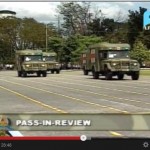 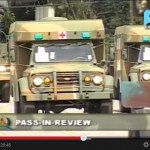 |
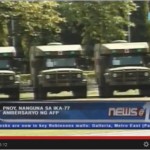 |
|
| Screen captures above from the video below | Screen capture above from the video below |
As a member of the KM-45x family of vehicles, the KM-451 builds upon the maintenance experience and spare-parts base of the KM-450 fleet. The first 100 KM-450s entered AFP service in December 12, 2007, and various batches have been delivered since as part of a project to acquire 651 1 1/4 ton trucks. A Timawa.net forum discussion about these ambulances is available here.
Other ambulances in AFP service include 23 units of the ambulance variant of the High Mobility Multipurpose Wheeled Vehicle (HMMWV) or “Humvee” which were delivered in November 2011, ambulance variants of the V-150 and Simba APCs, and various civilian ambulances. These vehicles are part of efforts to improve the AFP Forward Medical Support System.
The following screen capture of the Kia Motors Website for the KM-45x family of vehicles provides additional information about the KM-451 and other members of its vehicle family.
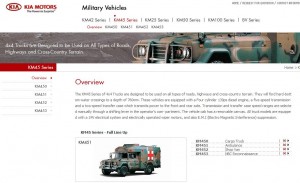 |
Ten months after delivery from Poland in February, and only weeks after the second-batch of two units arrived at Clark AFB, the Sokols have been deployed to their first high profile mission in COMPOSTELA Valley in support of relief operations in the wake of typhoon Pablo. The following screen capture from an ABS-CBN report shows two W-3As deployed, indicating satisfactory completion of the testing phase of the aircraft service career in the Philippine Air Force. The helicopters are first visible at time index 00:29 of the video.
 |
PAF: Waiting on the 5th attempt at getting Attack Helicopters
Saturday , 1, December 2012 Philippine Air Force Leave a commentThe Philippine Star confirmed what had been feared on the Timawa.net forum for months, the most recent attempt by the Philippine Air Force to acquire all-weather attack helicopters, had failed. It was the fourth project in a series of attempts that dated back to 2006.
The focal point for this effort were ten (10) Eurocopter AS550 Fennec helicopters that were reportedly originally destined for Pakistan. The deal had been aborted, and Eurocopter sought alternative buyers for the helicopters that had already been manufactured and were simply in storage. Enter the Philippine Air Force.
The PAF had initially been slated to award Project #AFPMP-PAF-00-06-042 to Agustawestland for the armed version of its W-3 Sokol helicopters. Earlier, this company had received a contract for 8 of the transport version of this aircraft for the Combat Utility Helicopter (CUH) project. However on September 2010, the then incoming Secretary of National Defense, Voltaire Gazmin, issued a memorandum suspending further action on the Sokol-tender. The memorandum, which appears below, cited “possible collusion” as the rational for the deferment, which eventually became a cancellation that then led to the Fennec deal. After years of delays, the prospect of acquiring ready-to-go aircraft that were merely in storage appeared to be the ideal option.
| 3rd bid invitation | Investigation | |
 |
 |
The PAF, through the Department of National Defense, sought to acquire the Fennecs through a government-to-government arrangement with France. This was originally thought to be in accordance with the revised implementing rules and regulations issued by the Government Procurement Policy Board, which granted the DND leeway in pursuing negotiated procurement for modernization items provided it had Presidential approval. The DND sought the GPPB’s approval in June of 2012. The GPPB, however, denied this request citing that the DND was negotiating directly with the supplier of the Fennecs, and not the French government itself. In November 2012, the Philippine Star reported that the GPPB reversed itself, and granted permission to pursue negotiations provided the French government was directly involved in the transaction.
Unfortunately for the PAF, Pakistan had revived its acquisition effort for the 10 Fennecs in the interval between GPPB intereactions. Therefore when the DND returned to the negotiating table, the original helicopters were no longer available. Where the PAF goes from here, whether it pursues an order of new-build Fennecs, or it seeks alternative suppliers, remains unclear at this time.
Prior to the Fennec and Sokol efforts, the PAF mounted the following unsuccessful attempts at supplementing its fleet of MD520 gunships with more capable helicopters that could operate at night.
| Project | IAETB | Qty | Budget | Status |
| Night Capable Attack Helicopter (NCAH) | TBA | 6 | P1,200,000,000 | Initially awarded to Asian Aerospace for MD530F. Award decision on January 7, 2008 cancelled due to irregularities. See here for details. |
| Attack Helicopter (AH) acquisition projectProject# AFP-MP-PAF-00-08-42 | 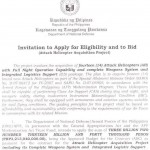 |
14 | P3,213,040,000SARO# D-0706412 FY2007 SARO# D-07-05905 |
Failed bidding declared |
Aerotech awarded P69.5M contract for MSI of PAF S211
Wednesday , 21, November 2012 Air Force, S211 Leave a commentAerotech Industries Philippines was awarded a P69,482,840.81 contract to perform a Major Structural Inspection (MSI) of S211 #021 of the Philippine Air Force. Teresa Parian, CEO of the company was given notice on the 6th of November 2012.
MSI, alternatively referred to as Programmed Depot Maintenance (PDM) or Inspection Replace As Necessary (IRAN), is a process by which the subject aircraft is taken apart and all its components — with the exception of the engine, ejection seat, and similarly self-contained systems — are evaluated and then replaced when required.
As per the DND’s 1st semester Procurement Monitoring Report, it issued the following resolutions in connection with this project.
| March 1, 2012 | Pre-procurement conference
DND BAC Resolution No. AFPMP-PAF-MSI-12-001 and 002 – Resolution recommending to the SND the use of alternative mode of procurement (Direct Contracting) in lieu of Public Bidding for the procurement of services for MSI of S211 Project of the PAF |
|
| June 8, 2012 | Change in the mode of procurement from Public Bidding to Direct Contracting and the creation of the negotiating committee for the project. Approved and signed by the SND | |
| June 21, 2012 | BAC resolved to approve the Terms of Reference, Timelines and the Post Qualification Plan |
A copy of the Notice of Award appears below
 |
For additional information about efforts to keep the S211 in the air, see the following Timawa.net thread.
A drastic solution to erase the monicker: “reservist ka lang”
Sunday , 4, November 2012 Uncategorized Leave a commentOne long-standing source of friction between regular and reserve members of the AFP has been the contentious issue of rank assignment. While the matter has been an often-side-stepped elephant-in-the-room for years, it came to the fore in late 2011, when reservists themselves raised questions in social media about the direct promotion of Congressman Emmanuel “Manny” Pacquiao from Senior Master Sergeant (a rank he received on May 4, 2009) directly to Lieutenant Colonel. Current regulations apparently allow such things to happen. His meteoric rise in the Non-Commissioned Officers ranks were by virtue of his prowess in the boxing ring, while his promotion to officership was by virtue of Sec. 44 of RA 7077 which states.
SEC. 44. Elected Officials and Presidential Appointees. -Elected officials and presidential appointees may be commissioned in the Reserve Force subject to the existing AFP rules and regulations.
It highlighted the state of affairs with regard to rank assignment in the reserves. Reservists, who had been faithfully serving in the reserves for years without a defined path to promotion, lamented the ease with which command privilege could be used to hand out ranks. If reservists can find fault, one can only imagine how professional soldiers feel about this, and how it affects their attitudes toward the force as a whole.
This article postulates that rank assignment procedures plays a part in fostering the prevailing AFP attitudes towards the reserve force as a whole. It also offers a drastic solution that may give reserve force offers a clear cut way to earn their ranks in a manner that is beyond reproach. This was first posted by the author on Timawa.net on March 26, 2011.
Background
By the time a regular officer reaches the rank of Major, he/she is expected to have already achieved a certain level of command experience and required schooling. Whereas the advance to Captain is often regarded as being almost automatic, earning a “sun” is where officers really have to work at it. A fair number of military careers actually end at the rank of Captain, when promotions to the next rank either become unlikely or do not occur in a timely manner.
The same is true of regular Non-Commissioned Officers (NCO). One does not become a staff sergeant without having put in one’s share of time in the field, and/or field of specialization. NCOs are regarded as the backbone of the AFP, specifically because they are the epitome of “been-there-done-that”.
In the reserves, on the other hand, such ranks are often assigned with no regard to a reservist’s combat record or comparable performance metric. Perusal of reservist rosters will reveal scores of Majors and above, and supposed senior NCOs, who have neither been under fire, nor experienced in managing real-life crisis/emergencies, and are therefore unexposed to the challenges their equivalents in the regular force are already expected to have experienced. Prevailing regulations even allow the automatic assignment of the rank of Lieutenant Colonel from the outset, without requiring the recipient to have experienced the four preceding levels.
A fair number of reservists on the Timawa.net forum have lamented disparaging comments from regulars about being told “reservist ka lang”. One reservist in particular brought up the issue that this disrespect of reservist ranks runs contrary to regulations pertaining to military courtesy and discipline.
On paper, the complaint is valid. An officer, right or wrong, is accorded a level of respect by military regulations. All those below his rank, are expected to extend the appropriate courtesy. But given the general prevailing rank-assignment policies in the reserves, strict enforcement of such regulations is a slap-in-the-face for career military men who attain their ranks through blood, sweat, and tears.
If regular officers/soldiers look down upon their peers who spend more time in headquarters than in the field,what attitude would you expect from them when faced with reservist officers whose boots had never tasted mud?
The disconnect between ranks and actual qualifications needs to be addressed. If reservist ranks are to be respected — both on paper and in practice — the reserves must shed the perception that it is populated with unqualified officers.
Proposals
1. Re-establish the rank of Third Lieutenant, and creation of an enlisted rank tentatively called “Kawal”
2. Establish a point system to qualify for promotions
3. Set maximum ranks for reservists
4. Match promotion requirements in the reserves with those of the regulars, an ensure reservist access to these trainings
Each is explained in the “Details” section.
Desired outcome
1. Eliminate the rank-skill-set mismatch in the reserves
2. Create incentives for participation in unit activities and for participation in the technical service
3. Encourage the entry of retired AFP personnel in the reserves
Details
Re-establish the rank of Third Lieutenant and establish the rank “Kawal”
“Third Lieutenant” would be the starting point for all reserve officers, putting them below 2nd Lieutenants.
Adding this layer gives the reserve force rank structure room for upward mobility, while avoiding questions about qualifications, particularly when comparing entry level reservist officers with graduates of regular-officer training programs (e.g., OCS, PMA, PAFROPP, PAFFS, etc.). Third Lieutenant is the rank that Marcos started with. If was good a enough starting point for the strongman, it should be good enough for everyone else. From the strongman’s MOV writeup: http://www.army.mil.ph/VALOR_AWARDEE/marcos.html
2. MAJ FERDINAND E. MARCOS
. . . Then 3rd Lieutenant Marcos led a hastly organized company-sized blocking force from remnants of 4 units. The defensive action against 2,000 highly-trained and well-equipped men prevented the possible decimination of the withdrawing USAFFE Troops and delayed the inevitable Fall of Bataan.
Advancement to 2nd Lieutenant would be contingent on a reservist officer’s demonstration of the skills that are expected of a regular 2nd Lieutenant.
To implement this, the AFP Reserve Command would have to draft a list skill-sets that a reservist officer would need to have to match their peers, thus giving officers a proper, clear-cut, path to advancement. Members of the Technical Services, who acquire their advanced ranks by virtue of their degree and direct, full-time, service to the AFP would naturally be exempted from this process.
“Kawal” would be a new rank, one grade below Private, and would form the first rank assigned to reservists immediately after completion of training. Reservists should be encouraged to move beyond this rank by matching minimum physical fitness, marksmanship, and other standards that all Privates/Seamen/Airmen are expected to meet. As with officer requirements, the AFP Reserve Command must draft a proper skills requirements so that reservists are given a fair chance at advancement.
A Private in the reserves must possess the exact same skills that a Private in the regular force. Until that is demonstrated, a reservist is “Kawal”.
Point-system to qualify for promotions
To qualify for promotion in a particular year, reservists must earn qualfication points by performing functions such as the following (Let us temporarily set aside discussion about how many points are assigned per activity):
– Active membership in the Ready Reserves with corresponding participation in unit activities
– Service as assistant military instructors in ROTC units
– Participation in mobilization, both actual and simulated
– Performance of public service functions (e.g. law enforcement, etc.)
The point system should be designed to attract individuals with skills that are useful in a crisis (e.g., paramedics, firemen, safety officers, security officers, Red Cross volunteers) or possession special qualifications (e.g., marine engineers, ship captains, etc.) to join the reserves since the regular performance of their jobs — by itself — already gives them a leg up. It would also mean that, for example, an accountant or a clerk whose day-to-day activities do not promote maintenance of relevant skills must take it upon himself to get involved in additional activities that put him in the running for advancement.
Failure to respond to mobilization calls will result in deduction of points from points already accrued. Point deficits will be recorded and carried over year-after-year, and can only be extinguished by continued accumulation of points or with active military service (this includes techncal services).
Another consequence of this system is that it rightfully slows down promotions in the StandBy Reserves, thus creating an incentive to join the Ready Reserves.
Set maximum ranks for reservists
This proposal is central to addressing the rank-qualification issue.
Reservists who have not rendered at least two years of active military service (to include the Technical Services and the CAFGU) will not be allowed to possess ranks above Captain. The practice, therefore, of assigning Lieutenant Colonel ranks to graduates of the Masters in National Security Administration would need to be discontinued.
Rank caps would be as follows:
-> Captain for officers
-> Sergeant for enlistedmen
That means whenever you see a Major in the reserves . . . this is a person who REALLY knows the functions that Majors are expected to be able to perform.
Understandably . . . this would create situations where Captains command reserve divisions.
Match promotion requirement in the reserves with those in the regular force
Any reservist seeking ranks beyond captain must satisfy the same promotion experience requirements that a regular captain would.
This would virtually eliminate lingering doubts about the skill-sets of mid-level officers in the reserve force. One of the underlying sources of . . . separation . . . therefore, would be eliminated.
This equal-opportunity policy, however, would require the AFP to take steps to accommodate reservists in their training programs, and fully implement the following provisions of RA 7077:
http://adroth.ph/reservist/law/7077/art9.htm
SEC. 51. Training of Individual Reservists and Reserve Units. – Maximum opportunity shall be afforded the reservists to update their skills through compulsory or voluntary training. Such training shall have for its principal purpose the enhancement of the readiness of the individual reservists and reserve units to respond to the call to service. To this end, there shall be two (2) types of training:
(1) Compulsory training of not less than thirty (30) days but not more than sixty (60) days for reserve units and/or individual reservists in a given year preferably to First Category Reservists; and
(2) Voluntary training subject to the capability of the AFP to provide the training. Individual reservists, commissioned and noncommissioned officers shall be encouraged to undergo training on a voluntary basis to upgrade their proficiency with priority to the officers and key noncommissioned officers of the Standby Reserve units. The Secretary of National Defense shall prescribe the course of instruction for the aofrementioned training. The services of qualified individual enlisted and officer reservists shall be utilized to the maximum in the conduct of ROTC and reservists’ training.
As a consequence of such a drastic increase in requirements, the following adjustments would arguably have to be implemented. Barriers to reservist participation in these courses must be eliminated.
-> Key advanced officer courses must have slots specifically for reservists that seek further military schooling. An LTC in the reserves who doesn’t have a GSC, for example, must be given a chance to earn it.
-> Certain basic combat courses should also be opened to reservists
-> Military Occupation Specialties (MOS), other than Infantry, must be made available
-> State colleges and universities must make their athletic facilities available to any reservist that seeks to use them to prepare for Physical Fitness tests. Singapore, for example, does this because it regularly tests the physical fitness of their reserve force.
-> Police and AFP firing ranges must be open to reservists and possess a minimum amount of ammunition for marksmanship practice for reservists. Reservists must be both taught how to shoot, and allowed to remain proficient.
If the AFP is serious about maintaining a competent reserve force, then it must provide training for both the reservists themselves, and for the regulars who may lead and look after their welfare in a crisis.
Transition
Implementation of a change this drastic will undoubtably ruffle feathers. So a transition plan must be put in place, for example 5 years from the time of implementation, to give reserve units a chance to disseminate the relevant information, and to give reservists a chance to make the relevant adjustments.
All existing reservists ought to be given the right retain their current ranks. It isn’t their fault that the reservist system they walked into was flawed, and therefore, should not be penalized for it. However, they must be subject to qualification tests and peer reviews to determine their suitability for the positions they hold. Failure to do so within a prescribed amount of time (for example the 5 years stated above) could, for example, result in automatic demotion by one rank per year of avoidance. This should bring most people to within the prescribed rank-range.
Ultimately, the goal of this proposal is to assure all parties concerned that a reservist, at any rank, is at par with his/her contemporaries in the regular force — in all aspects. Not only does this relegate the “reservist ka lang” phrase to the vocabulary of the close-minded who cling to pre-conceived notions without the benefit of fact-checks, but also guarantees that the Filipino people get the reserve force that they both need . . . and deserve.
On the 31st of October, the Philippine Navy opened a bid invitation for the supply and delivery of two units of overhauled Lycoming engines for a Norman-Britten Islander on PhilGEPS. The invitation, with an Authorized Budget for Contract (ABC) of P8M, will close on the 16th of November 2012.
Islanders are the fixed-wing workhorses of the PN Naval Aviation Group (NAG), which use them as its principal liaison and maritime patrol aircraft. Over the years, the NAG Islander fleet has gone through periodic refurbishment to extend their lives. The following video shows an Islander on a test flight after having undergone depot-level maintenance with Hawker Pacific in 2008.